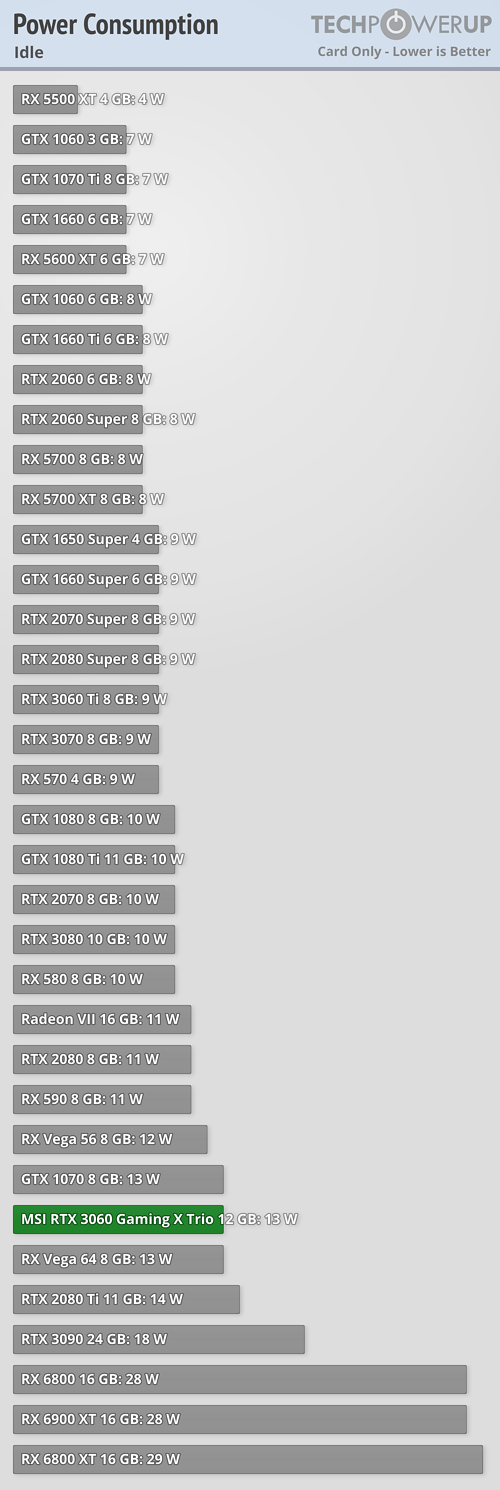 63
63
MSI GeForce RTX 3060 Gaming X Trio Review
Efficiency & Clock Speeds »Power Consumption
Our data acquisition system for graphics cards power consumption testing now runs at a higher sample rate, and automation capabilities have been expanded. With 40 samples per second, we're now collecting data much faster than before, four times as fast as NVIDIA's PCAT. Every single data point is recorded digitally—previously, we could only get averages and peaks.
Non-gaming power consumption of the GeForce RTX 3060 is a bit higher than comparable previous-generation cards from NVIDIA. Multi-monitor power draw is also much better than on AMD because AMD runs their memory clock at full speed in that state, while NVIDIA dials it down to conserve power.
With well below 200 W, power consumption is barely worth mentioning. It's slightly lower than with the RTX 2070/Super, but not by much, so PSU requirements are similar. Overall energy efficiency is slightly lower than on other Ampere cards, but still considerably better than what Turing offered.
Minimum recommended PSU: 550 W







Mar 21st, 2025 17:01 EDT
change timezone
Latest GPU Drivers
New Forum Posts
- GPU Review Test System 2025.2 Games & Planning (15)
- Old Gamer Memory Upgrade Worth It? (62)
- 2006 Macbook Pro Modern Sleeper Project (10)
- Cooling problems persist on LGA1700 (92)
- Post your Cinebench 2024 score (620)
- Does Linux take advantage of all the bells and whistles offered by the Intel Core Ultra Series-2 (Arrow Lake) processors? (5)
- Post your Cinebench R23 Score (3055)
- Question about Intel Optane SSDs (33)
- Suggestion for lightweight Image Viewer / GTK2 has to go (4)
- 17 13620H + phase change pad = murder fuel for my cpu. (0)
Popular Reviews
- ASRock Radeon RX 9070 XT Taichi OC Review - Excellent Cooling
- Assassin's Creed Shadows Performance Benchmark Review - 30 GPUs Compared
- Sapphire Radeon RX 9070 XT Nitro+ Review - Beating NVIDIA
- be quiet! Pure Base 501 LX Review
- AMD Ryzen 9 9950X3D Review - Great for Gaming and Productivity
- MSI MAG B860 Tomahawk Wi-Fi Review
- Corsair SF750 750 W Review
- ASUS GeForce RTX 5070 TUF OC Review
- XFX Radeon RX 9070 XT Mercury OC Magnetic Air Review
- ASUS Radeon RX 9070 TUF OC Review
Controversial News Posts
- NVIDIA GeForce RTX 50 Cards Spotted with Missing ROPs, NVIDIA Confirms the Issue, Multiple Vendors Affected (519)
- AMD RDNA 4 and Radeon RX 9070 Series Unveiled: $549 & $599 (260)
- AMD Mentions Sub-$700 Pricing for Radeon RX 9070 GPU Series, Looks Like NV Minus $50 Again (250)
- NVIDIA Investigates GeForce RTX 50 Series "Blackwell" Black Screen and BSOD Issues (244)
- AMD Radeon RX 9070 and 9070 XT Official Performance Metrics Leaked, +42% 4K Performance Over Radeon RX 7900 GRE (195)
- AMD Radeon RX 9070-series Pricing Leaks Courtesy of MicroCenter (158)
- MSI Doesn't Plan Radeon RX 9000 Series GPUs, Skips AMD RDNA 4 Generation Entirely (142)
- Microsoft Introduces Copilot for Gaming (123)